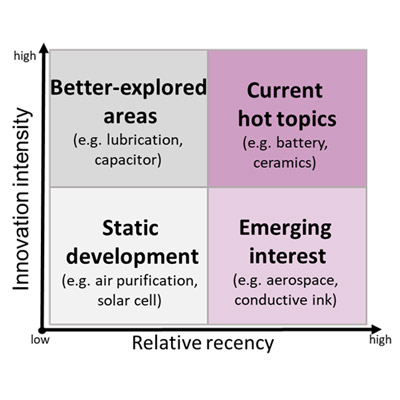
How Patent Information Can Help Spot Technology Gaps and Catalyze Economic Development
By Lakshmi Supriya, Technology and Innovation Support Division, WIPO
When a group from the National Innovation Agency (NIA), Sri Lanka, asked the WIPO Patent Analytics Team how they could add value to their rich natural resources to boost their economy, we decided to dig into patent data. In itself, this was not unusual as we regularly look for innovation trends in this way, but what we were looking for this time was rather different.
Patent applications contain a lot of information: who filed the application, when, and where, who are the inventors and so on. Analyzing this information can lead to useful insights, including about the general state-of-art in a particular technology area; how the number of applications rises and falls over the years, and where the innovation is happening. By slicing patent data in different ways, it is also possible to find areas where patenting activity is relatively lower —the “white space.” And this is where at least part of the answer to NIA team’s question is found.

Probing patent data to support national economic growth
“Sri Lanka is very rich in minerals,” says Vindya Wijesinghe, Senior Innovation Officer, NIA, “and has the purest graphite. It is being called black gold.” The problem is, she notes, “we have been exporting the majority of it only as the raw materials.” Simply exporting the mineral ore is not as profitable as first converting it into useful products and then selling them. But, what products? There is no simple answer. We decided to take a closer look at patents related to graphite, with the idea of identifying technology areas that were not already saturated with patent filings.
Many patents in a technology area suggest that a lot of groundbreaking innovation has already been done. In such cases, any further innovation is likely to be incremental, leaving little room to capture intellectual property. Moreover, many of the foundational technologies may have been patented. And that means anyone seeking to use these technologies may need to invest a lot of effort to obtain the rights to use them to ensure there is no inadvertent or infringing use of those inventions.

Navigating patent information
One way to circumvent these challenges is to find technologies that are not well fortified by patents.
To tease this out from patent data, we drew up a list, categorizing graphite products and their applications based on reading, talking to experts and our own technical expertise. Then we counted the number of patent applications in each of these categories to measure innovation intensity. We also noted the year the applications were filed, to measure what we call “recency.” The higher the recency number, the more recent the patents. If we plot innovation intensity against recency on a chart for each of the categories, we get a sense of where the white spaces are.
An application area with many older patents - or a high innovation intensity number - and a low recency number, suggests a mature technology area. Conversely, areas with a few, relatively newer patents suggests an area with potential space to innovate. Figure 1 shows a chart divided into four quadrants, with the top right quadrant indicating current hot topics of innovation and the bottom right quadrant the emerging areas.

Geneva: World Intellectual Property Organization.
Analysis of patent information reveals innovation windows
For graphite, we found that its use in aerospace and packaging could be potential emerging areas. Another interesting application area where fewer patents have been filed relatively recently is conductive inks.
Traditionally, conductive inks—inks that can be printed and used in flexible electronics, think foldable cell phones—are made of very small particles of conductive metals like silver and gold dispersed in a fluid. Graphite is also a good electrical and thermal conductor. The study shows that the use of graphite in conductive inks is an area where patenting activity is low. Graphite-based conductive inks make up about 5 percent of the total patent filings in the area of conductive inks in the last 10 years, with smaller research institutions filing more patent applications than large corporations like Samsung and HP who dominate the traditional conductive ink market.
Our analysis of patent information suggests there is likely a space to innovate in graphite-based conductive inks.
Patent analytics: a good starting point, but not the whole story
Although analyzing patents like this can provide a good indication of white spaces, it is important to keep in mind that patents are only one indicator of innovation. There are also many other forces that could explain why there are gaps in patenting or innovation in a particular technology area.
Taking conductive inks as an example, there may be technical reasons why patent filings are low in this area. These inks may not be as conductive or robust as conventional inks or more fundamental scientific research may be needed to understand their conductive properties. It may also be that market demand is currently low for these products. While patent information can reveal useful insights and is a helpful starting point, such analyses cannot paint a complete picture for investment decisions, which should be based on a more holistic analysis of the full range of factors at play.
This is exactly what Wijesinghe and her team at NIA are doing. They are using the insights from patent analytics as foundations on which to build and advance their innovation journey. “These reports are catalysts for shaping the mineral roadmap and policy in Sri Lanka,” she says.
WIPO and Patent Analytics
Since 2010, at the request of member states, WIPO has been mining patent information to explore innovation trends in various technology areas and regions. This work has culminated in a number of patent landscape reports and resources for doing such analysis. In addition, going beyond patent data, the WIPO Technology Trends reports, combine scientific literature, expert views, and other types of data to provide a deeper look at specific technology areas.
These resources and reports are freely available at online.
The WIPO Magazine is intended to help broaden public understanding of intellectual property and of WIPO’s work, and is not an official document of WIPO. The designations employed and the presentation of material throughout this publication do not imply the expression of any opinion whatsoever on the part of WIPO concerning the legal status of any country, territory or area or of its authorities, or concerning the delimitation of its frontiers or boundaries. This publication is not intended to reflect the views of the Member States or the WIPO Secretariat. The mention of specific companies or products of manufacturers does not imply that they are endorsed or recommended by WIPO in preference to others of a similar nature that are not mentioned.